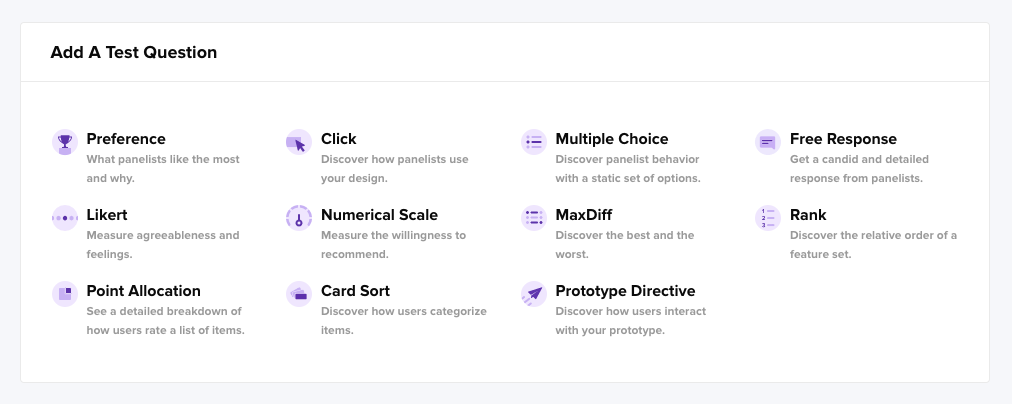The Importance of User Experience Surveys: Enhancing Customer Satisfaction
In today’s highly competitive business landscape, understanding and meeting your customers’ needs is essential for long-term success. One powerful tool that can help you achieve this is user experience surveys. By gathering feedback from your customers, these surveys provide valuable insights into how your products or services are perceived and experienced by users. This information can help you make informed decisions to enhance customer satisfaction and drive business growth.
🔩 The Nuts and Bolts:
- Direct Pathway to Customer Insights
User Experience Surveys are instrumental in capturing comprehensive feedback, offering a nuanced understanding of customer interactions and preferences. - Strategic Tool for Product Improvement
These surveys provide actionable data, enabling businesses to pinpoint areas of improvement, align products with customer expectations, and foster innovation. - Enhances Customer Loyalty and Trust
By valuing customer feedback through User Experience Surveys, businesses foster a deeper connection with users, enhancing brand loyalty and trust. - Quantitative and Qualitative Feedback Synergy
The blend of quantitative and qualitative feedback from User Experience Surveys offers a holistic view, allowing for more nuanced and informed business strategies. - Competitive Advantage through User Insights
Insights gained from User Experience Surveys empower businesses to outperform competitors by identifying and leveraging unique value propositions. - Informs Targeted Marketing Strategies
Detailed user feedback guides tailored marketing approaches, ensuring messaging and campaigns resonate more effectively with the target audience. - Continuous Improvement Loop
Regular implementation of User Experience Surveys establishes a feedback loop, promoting continuous product evolution and customer satisfaction.
Understanding User Experience Surveys
Before diving into the benefits of user experience surveys, it’s essential to understand what they are and how they work.
User experience surveys are questionnaires or forms designed to gather feedback about a user’s experience with a specific product, service, or website. These surveys typically include a range of questions that aim to uncover both positive and negative aspects of the user’s experience.
When understanding user experience, gathering feedback directly from the users is crucial. User experience surveys provide a structured way to collect this feedback, allowing businesses to gain valuable insights into how their customers perceive their offerings.
Defining User Experience Surveys
User experience surveys can take various forms, such as online questionnaires, in-person interviews, or phone surveys. The choice of survey method depends on the target audience, the nature of the product or service, and the study’s goals.
Online questionnaires are a popular choice for user experience surveys due to their ease of administration and scalability. These surveys can be distributed to many users simultaneously, allowing for efficient data collection. In-person interviews, on the other hand, provide an opportunity for more in-depth discussions and observations, enabling researchers to gain a deeper understanding of the user’s experience.
Regardless of the survey method chosen, it’s essential to carefully design the questions to ensure they capture the relevant information. User experience surveys often include a mix of closed-ended and open-ended questions. Closed-ended questions provide predefined response options, making analyzing and quantifying the data more accessible. On the other hand, open-ended questions allow users to provide detailed feedback and insights that closed-ended questions may not capture.
The Role of User Experience Surveys in Business
User experience surveys play a crucial role in business decision-making. They provide valuable insights that can help you identify areas of improvement, uncover customer pain points, and understand how your offerings compare to competitors. With this knowledge, you can make data-driven decisions to enhance your products, services, and overall customer experience.
By collecting feedback directly from users, businesses can better understand their target audience’s needs, preferences, and expectations. This information can then inform product development, marketing strategies, and customer support initiatives.
Moreover, user experience surveys can help businesses measure and track customer satisfaction over time. By regularly conducting surveys, you can monitor changes in customer sentiment and identify trends that may impact your business. This allows you to address any issues and continuously improve the user experience proactively.
Additionally, user experience surveys can provide a competitive advantage. By understanding how your offerings compare to competitors in terms of user experience, you can identify areas where you excel and need to catch up. This knowledge can guide your efforts to differentiate your brand and stay ahead in the market.
In conclusion, user experience surveys are valuable for businesses looking to enhance their products, services, and overall customer experience. By gathering feedback directly from users, companies can gain insights that inform decision-making, drive improvements, and, ultimately, create a more satisfying user experience.
Make your design decisions count.
Subscribe to Design Under Pressure. Get insights, UX metrics, and tools for bold, informed design.
We respect your inbox. Just insights. No fluff. Privacy Policy.
The Connection between User Experience and Customer Satisfaction
User experience and customer satisfaction are closely intertwined. The quality of a user’s experience directly impacts their satisfaction levels, influencing their likelihood of becoming repeat customers and advocates for your brand.
User experience is about creating a seamless and enjoyable journey for your customers. From the moment they land on your website or interact with your app, every touchpoint should be designed with their needs and preferences in mind. This includes intuitive navigation, clear and concise content, and visually appealing design elements.
Imagine a customer visiting an e-commerce website to purchase a new pair of shoes. They expect a smooth and hassle-free experience, from finding the desired product to completing the checkout process. If the website is slow to load, the product descriptions are unclear, or the payment gateway is glitchy, the user’s experience will be frustrating and unsatisfactory.
Conversely, a well-designed user experience can leave a lasting positive impression on customers. Imagine visiting a website where every page is thoughtfully laid out, with easy-to-find information and a visually pleasing aesthetic. The navigation is intuitive, guiding you effortlessly through the site, and the checkout process is seamless. This kind of experience satisfies the customer’s immediate needs and builds trust and loyalty.
How User Experience Impacts Customer Satisfaction
A seamless and enjoyable user experience can leave a lasting positive impression on customers. Conversely, frustrating or confusing expertise can lead to dissatisfaction and even prompt customers to seek alternatives. Monitoring and improving the user experience can bolster customer satisfaction and build long-lasting relationships.
One way to enhance user experience is through personalization. By tailoring the experience to individual preferences and behaviors, you can make customers feel valued and understood. This can be achieved through personalized recommendations, targeted marketing campaigns, and customized user interfaces.
Another critical aspect of user experience is responsiveness. Customers expect websites and apps to load quickly and function flawlessly across different devices in today’s fast-paced digital world. A slow or unresponsive interface can quickly lead to frustration and abandonment. By optimizing performance and ensuring compatibility across devices, you can provide a seamless experience that keeps customers satisfied.
The Role of Customer Satisfaction in Business Success
Customer satisfaction is key to business success. Satisfied customers are likelier to become loyal brand advocates, refer friends and family, and provide positive reviews and testimonials. Conversely, dissatisfied customers can have a detrimental impact on your brand reputation and bottom line. By prioritizing customer satisfaction, you can retain existing customers and attract new ones through positive word-of-mouth.
Customers who are satisfied with their experience are more likely to engage with your brand on a deeper level. This could include subscribing to newsletters, following your social media accounts, or participating in loyalty programs. These engaged customers contribute to your revenue and become valuable assets in spreading the word about your brand.
Moreover, customer satisfaction plays a crucial role in building trust. Customers who feel satisfied and valued are more likely to trust your brand and its offerings. Trust is fundamental in establishing long-term customer relationships, as it creates a sense of reliability and credibility.
By continuously monitoring and improving customer satisfaction, you can identify areas for enhancement and ensure that your business meets and exceeds customer expectations. This can be done through surveys, feedback forms, and analyzing customer interactions. By actively listening to your customers and considering their feedback, you can make informed decisions that lead to improved satisfaction levels and ultimately drive business success.
Designing Effective User Experience Surveys
Creating user experience surveys that elicit valuable feedback requires careful consideration and strategic planning. Businesses can make informed decisions and improve their products or services by designing surveys that effectively capture user insights.
When designing a user experience survey, key elements that address various aspects of the user experience must be included. Questions could cover ease of use, visual appeal, performance, navigation, and level of satisfaction. By asking targeted questions, businesses can better understand how users interact with their products or services.
One crucial element to consider when designing a user experience survey is including open-ended questions. These questions allow participants to provide specific suggestions and feedback, giving businesses valuable insights into areas for improvement. Open-ended questions also enable participants to share their thoughts and ideas, which can lead to innovative solutions and enhancements.
Best Practices for Survey Design
To maximize response rates and the quality of responses, it’s essential to follow best practices for survey design. Keeping the survey concise is crucial, as participants are more likely to complete shorter surveys. Long and complex surveys can lead to survey fatigue and decreased response rates.
Another best practice for survey design is using clear and simple language. Participants should be able to understand the questions quickly and provide accurate responses. Avoid using technical jargon or complicated terminology that may confuse participants and lead to inaccurate data.
Offering multiple response options for quantitative questions is also recommended. This allows participants to choose the option that best represents their opinion or experience. By providing a range of response options, businesses can gather more nuanced data and gain a deeper understanding of user preferences and perceptions.
Additionally, consider incentivizing participants to encourage higher participation rates. Rewards or incentives, such as discounts, gift cards, or exclusive access to new features, can motivate users to complete the survey. Incentives increase response rates and show appreciation for participants’ time and effort.
In conclusion, designing effective user experience surveys requires careful consideration of critical elements and adherence to best practices. Businesses can gain valuable insights and make informed decisions by creating surveys that address various aspects of the user experience and incorporating open-ended questions. Following best practices for survey design, such as keeping the survey concise, using clear language, offering multiple response options, and incentivizing participants, can maximize response rates and the quality of responses. By continuously improving the survey design process, businesses can enhance their understanding of user needs and preferences, leading to better products and services.
🚀 If you’re using Helio
Follow best practices for survey design, such as keeping the survey concise, using clear language, offering multiple response options.

By continuously improving the survey design process, businesses can enhance their understanding of user needs and preferences.
Analyzing User Experience Survey Data
Once you have collected many survey responses, the real value lies in analyzing and interpreting the data.
Interpreting Survey Results
Thoroughly analyzing survey results allows you to identify patterns, trends, and areas for improvement. Look for recurring themes, common pain points, and suggestions that illuminate opportunities to enhance the user experience.
Turning Data into Actionable Insights
Raw survey data alone is not enough. To derive actual value from the feedback, it’s important to turn the data into actionable insights. Use the findings to inform decision-making, prioritize areas for improvement, and implement strategies to enhance the user experience.
Implementing Changes Based on Survey Results
Once you have gathered insights from the user experience surveys, it’s time to put those findings into action.
Strategies for Effective Implementation
Effective implementation of changes requires a thoughtful approach. Prioritize the identified areas for improvement based on their impact on customer satisfaction and business goals. Develop action plans, allocate resources, and involve relevant stakeholders to ensure successful implementation.
Monitoring and Evaluating Changes
Implementing changes is only the first step. Continuously monitor and evaluate the impact of the implemented changes on the user experience and customer satisfaction. Use additional surveys or feedback channels to gauge the effectiveness of the changes and make further adjustments if necessary.
Conclusion
User experience surveys are a powerful tool for enhancing customer satisfaction and driving business success. By understanding the role of user experience in customer satisfaction, designing effective surveys, and analyzing the data to make informed decisions, you can improve your products, services, and overall customer experience. Embrace user experience surveys as an ongoing process, and you’ll be well-positioned to meet your customers’ needs and stay ahead of the competition.
Survey Feedback FAQs
User Experience Surveys are structured questionnaires designed to gather feedback about a user’s experience with a product or service. They aim to uncover positive and negative aspects of the experience and guide businesses in enhancing usability, satisfaction, and overall customer experience.
These surveys are vital as they provide direct insights from customers. They help businesses identify improvement areas, understand customer pain points, and tailor products to meet user needs. This feedback is essential for making data-driven decisions that improve product quality and customer satisfaction.
By identifying user needs and preferences, these surveys enable businesses to make informed improvements to their products and services. This leads to a more enjoyable and seamless user experience, significantly enhancing customer satisfaction and fostering loyalty.
Effective user experience surveys should contain closed-ended and open-ended questions, focusing on usability, satisfaction, and product preferences. Surveys must be concise, use precise language, and be designed with the target audience in mind to ensure meaningful and actionable feedback.
Businesses can offer incentives to boost participation, ensure the survey is concise and straightforward, and distribute it across multiple channels. It’s also essential to communicate the survey’s value to participants, showing how their feedback improves the product or service.
Businesses should avoid leading questions, overly complex or technical language, and excessively long surveys that can lead to respondent fatigue. Ensuring questions are neutral and directly related to the survey’s objectives is crucial for collecting unbiased and valuable feedback.
Analyzing survey results involves looking for trends, patterns, and actionable insights. Businesses should prioritize changes based on feedback impact, develop clear action plans, and monitor the effectiveness of implemented changes through follow-up surveys or metrics analysis. This process helps ensure continuous improvement and customer satisfaction.



